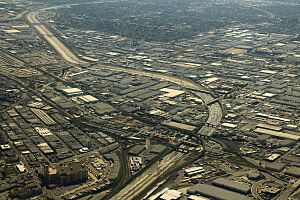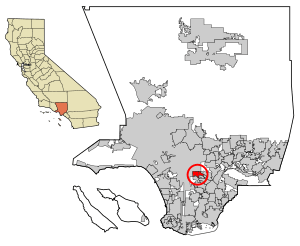Vernon, California facts for kids
Quick facts for kids
Vernon, California
|
|||
|---|---|---|---|

Aerial view of Vernon
|
|||
|
|||
| Motto(s):
"Exclusively Industrial!"
|
|||

Location of Vernon in Los Angeles County, California
|
|||
| Country | United States | ||
| State | California | ||
| County | Los Angeles | ||
| Incorporated | September 22, 1905 | ||
| Government | |||
| • Type | Council-Administrator | ||
| Area | |||
| • Total | 5.16 sq mi (13.36 km2) | ||
| • Land | 4.97 sq mi (12.88 km2) | ||
| • Water | 0.18 sq mi (0.48 km2) 3.57% | ||
| Elevation | 203 ft (62 m) | ||
| Population
(2020)
|
|||
| • Total | 222 | ||
| • Estimate
(2023)
|
209 | ||
| • Density | 44.66/sq mi (17.2/km2) | ||
| Time zone | UTC-8 (Pacific) | ||
| • Summer (DST) | UTC-7 (PDT) | ||
| ZIP code |
90058
|
||
| Area code | 323 | ||
| FIPS code | 06-82422 | ||
| GNIS feature IDs | 1661636, 2412150 | ||
Vernon is a small city in California, located about 5 miles (8 km) south of downtown Los Angeles. It's known for being almost entirely made up of factories and warehouses. In fact, its motto is "Exclusively Industrial!"
Vernon has a very small population. In 2020, only 222 people lived there, making it one of the least populated cities in California. Even though few people live there, many thousands of people work in Vernon every day.
Contents
Vernon's History
Early Beginnings

Vernon is famous for being the site of the Battle of La Mesa on January 9, 1847. This battle was the last major fight between American forces and the Californios (people of Spanish or Mexican descent living in California) during the Mexican–American War. After this battle, the fighting in California ended.
By the early 1900s, the area that is now Vernon was mostly open grassland near Los Angeles.
Becoming a City
In 1905, Vernon officially became a city. It was started by ranchers James J. and Thomas J. Furlong, and a merchant named John B. Leonis. They wanted to create a city just for businesses and factories. This way, industries could grow along the railroad lines that ran through the area.
John Leonis helped convince railroad companies to build special tracks into the new city. He made Vernon the first "exclusively industrial" city in the southwestern United States. He named it after Vernon Avenue, a dirt road that crossed the area.
Sporting Town Era
For a short time, Vernon was also known as a "sporting town." In 1907, the city had the Vernon Arena, which was famous for its long boxing matches. A baseball park was also built, and the Vernon Tigers, a minor league baseball team, played there from 1909 to 1925. They even won championships in 1919 and 1920.
Vernon also had a very long bar and the Vernon Country Club, which was a popular spot for young Hollywood stars. This helped attract business owners to set up their factories in Vernon. By the 1930s, big companies like Owens-Illinois and Alcoa had facilities there.
Growth and Industry
Over the years, Vernon grew by adding more industrial areas. This helped ensure that the city remained focused on businesses and factories, while keeping residential areas separate.
A Studebaker car factory was built in Vernon in 1938. It was the only Studebaker factory on the West Coast and produced many cars each day. It closed in 1956.
In the 1940s and 1950s, more types of businesses came to Vernon. These included aerospace companies, paper manufacturers, drug companies, and food processors like General Mills. Meatpacking plants, such as Farmer John and Swift, also became very important industries.
Vernon even built its own city-owned power plant in 1932. This helped provide electricity to businesses at lower rates.
Vernon's China Companies
The Poxon China Company was founded in Vernon in 1913 by George Wade Poxon and his wife Judith. The Furlong family, who helped found Vernon, built St. Martha's Church in Vernon, where George and Judith were married.
Later, in 1931, a new company called Vernon Kilns took over Poxon China. They made dinnerware, art pottery, and other items. An earthquake in 1933 forced them to create new designs. Vernon Kilns was a successful company until the late 1950s when it was sold to another pottery company.
City Governance and Changes
For many years, Vernon's city government was run by a few families, especially the Leonis family. Leonis Malburg, John Leonis's grandson, became mayor in 1974 and served for 50 years.
Because Vernon had very few residents, and many of them were city employees, elections were not very competitive for a long time. This led to concerns about how the city was being run.
Efforts for Reform
In the mid-2000s, there were calls for more transparency in Vernon's government. People were concerned about high salaries for city officials and how elections were managed.
These concerns led to a big discussion about whether Vernon should remain a city or be absorbed by Los Angeles County. State lawmakers even proposed a bill to disincorporate (un-create) cities with very few residents, which would have affected only Vernon.
To avoid being disincorporated, Vernon's city leaders agreed to make major changes. They passed reforms in 2011, which included:
- Lowering the salaries of city council members.
- Reducing benefits for officials.
- Setting limits on department heads' salaries.
- Limiting city council members to two five-year terms.
- Opening up city-owned housing to the general public.
These changes aimed to make Vernon's government more open and fair.
Recent Progress
In 2015, Vernon's population almost doubled when new apartments were built and made available to the general public. This was a big step towards making the city more democratic, as it allowed more people not connected to city jobs to live and vote there.
Vernon's City Council has five members, each elected for a five-year term. The city is working to balance its industrial focus with more modern governance practices.
Geography
Vernon covers an area of about 5.2 square miles (13.5 square kilometers). Most of this area, about 5.0 square miles (12.9 square kilometers), is land. A small part, about 0.2 square miles (0.5 square kilometers), is water.
Demographics
| Historical population | |||
|---|---|---|---|
| Census | Pop. | %± | |
| 1910 | 772 | — | |
| 1920 | 1,005 | 30.2% | |
| 1930 | 1,269 | 26.3% | |
| 1940 | 850 | −33.0% | |
| 1950 | 432 | −49.2% | |
| 1960 | 229 | −47.0% | |
| 1970 | 261 | 14.0% | |
| 1980 | 90 | −65.5% | |
| 1990 | 152 | 68.9% | |
| 2000 | 91 | −40.1% | |
| 2010 | 112 | 23.1% | |
| 2020 | 222 | 98.2% | |
| U.S. Decennial Census | |||
As of the 2010 United States Census, Vernon had 112 residents. The population density was about 21.7 people per square mile. Most residents were White, and about 42.9% were of Hispanic or Latino background.
All 112 people lived in households. There were 28 households in total, with an average of 4 people per household. About 19% of the population was under 18 years old.
Most of the housing in Vernon is owned by the city government and rented to its employees.
Economy
Vernon's economy is almost entirely based on its many warehouses and factories. The main industries include:
- Food manufacturing
- Metalworking
- Making glass and plastic equipment
Many well-known food companies have facilities in Vernon, such as Bon Appetit Bakery, Papa Cantella's Sausages, and Tapatío Foods. Clothing brands like 7 for All Mankind and Lucky Brand Jeans also have operations there.
About 46,000 people work directly in Vernon businesses, and another 54,000 jobs are indirectly supported by these businesses.
Vernon provides special services designed for its industries:
- It has a highly-rated fire department.
- It has its own health department that focuses on industrial safety.
- It has its own police force.
- It has its own light and power department, which offers lower electricity rates to businesses.
These services help attract and keep businesses in Vernon. In 2008, Vernon was even named Los Angeles County's "Most Business Friendly City" for cities of its size.
Environmental Concerns
In the past, there were environmental issues related to a battery recycling plant called Exide in Vernon. This plant caused lead and arsenic contamination in nearby communities. California regulators permanently shut down the facility in 2015 due to these issues, and a major cleanup effort is underway.
Vernon is also home to the Derby Dolls, a roller derby league that competes regularly.
Churches
- Fellowship Community Church of L.A. (Southern Baptist Convention)
- Holy Angels Parish of The Deaf (Roman Catholic)
- St. John Bosco Catholic Church
Education
Vernon is part of the Los Angeles Unified School District. The closest public schools are:
- Vernon City Elementary School (located within Vernon)
- Holmes Ave Elementary School
- George Washington Carver Middle School
- Gage Middle School
- Huntington Park High School
Notable People
- Beulah Woodard (1895–1955), a sculptor.
- Jimmy Murphy (1894–1924), a racecar driver who won the 1922 Indianapolis 500.
Images for kids
See also
 In Spanish: Vernon (California) para niños
In Spanish: Vernon (California) para niños







